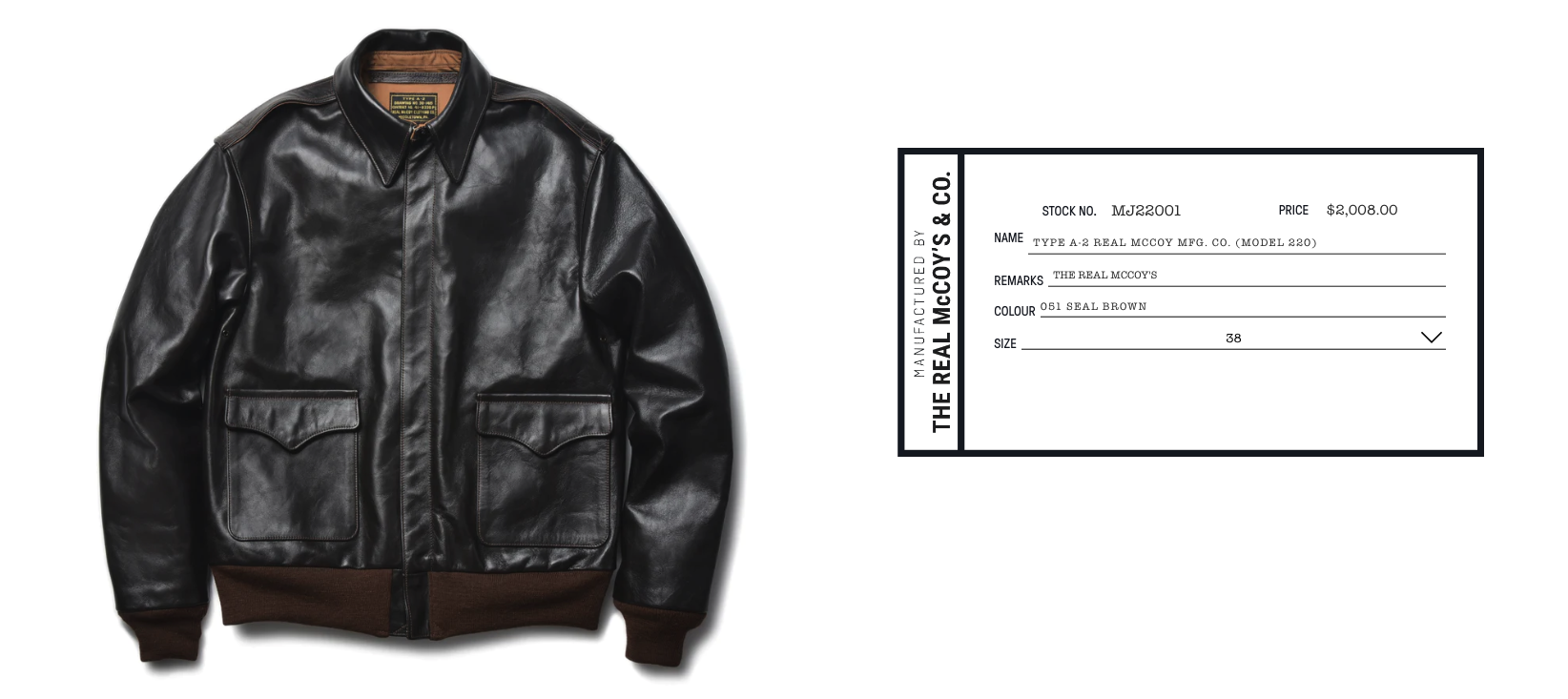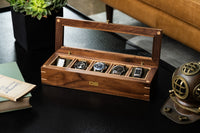When you hear the words “leather jacket,” what comes to mind?
Even with limited sartorial knowledge, there’s a healthy chance that it’s the A-2 that’s plastered across your brain — complete with images of bomber crews racing off to get their B-17s in the air. Though the A-2’s reputation was cemented during World War II, its story extends both before and long after that famed conflict. Ever since the guns went silent in 1945, it’s been worn by movie stars, musicians, and even presidents, and has become an icon of American bravado.
 Steve McQueen as Virgil 'The Cooler King' Hilts in The Great Escape wearing an A-2 - (Image by Heddels)
Steve McQueen as Virgil 'The Cooler King' Hilts in The Great Escape wearing an A-2 - (Image by Heddels)
Adopted in 1931 by the U.S. Army Air Corps, the “Jacket, Flying, Type A-2” succeeded the A-1 and was used by American air crews throughout the duration of the War — despite its official replacement in 1943. Consisting of a brown horsehide leather exterior with a knitted waistband and knitted wristlets, it featured (unlike its predecessor) a zippered front and either pocket buttons or hidden snap fasteners. Multiple brown tones were used by different contractors, but each was based upon two approved colors: seal (dark brown) and russet (pale to medium-brown). Notably, it was cut slim by today’s standards, which gave it an ideal fit on the trim, 1940s-era American military man’s silhouette.

A shirt-style collar replaced the A-1’s knitted, stand-up collar, while the addition of hidden snaps kept it out of the airman’s way. Epaulets for rank were fitted to the shoulders, and a broad range of sizes from 32 through 54 were offered. Other well known features include dual patch pockets with snap flaps either side of the zipper; a cotton inner lining (originally silk, though wartime needs for parachutes led to the switch to cotton); and a leather hang strap. Horsehide construction with vegetable or chrome tanning yielded a tough garment, though later iterations were made of goatskin or cowhide, depending upon the contractor. (Horsehide was relatively inexpensive just before the War, as the automobile was in the process of replacing workhorses, leading to a surplus of hide.) The back and front were cut from a single piece of leather — making for an excellent canvas for personalization — while the sleeves were formed from two pieces.
 Pilots in in A-2s during the Second World War - (Image by Gentleman Gazette)
Pilots in in A-2s during the Second World War - (Image by Gentleman Gazette)
Once an Army Air Forces officer completed basic flight training, he was issued his A-2 before proceeding to advanced training. Until the onset of the War, only commissioned officers received jackets, though eventually, enlisted aircrews were likewise included. Said officers and enlisted men would often decorate and personalize their jackets by adding nose art copied from their aircraft; bombs representing missions flown; or unit insignia. Pilots flying in the China-Burma-India Theater sometimes had a “blood chit,” printed on cloth, sewn into the jacket lining or back, promising a reward to the local population for helping to rescue the downed pilot.
 The personal A-2 worn by Louis H. Silvestry of the 714 SQ. 448th BG 8th AF (B-24s) - (Image by Hell's Angels)
The personal A-2 worn by Louis H. Silvestry of the 714 SQ. 448th BG 8th AF (B-24s) - (Image by Hell's Angels)
Though the A-2 with its leather exterior and cotton lining was somewhat warm, it was more comfortable in a heated or semi-heated environment such as a fighter plane cockpit. Thus, bomber crews were often better served wearing the fleece-lined Type B-3 jacket, such as that famously seen on General Patton. However, despite issuance limited to air crews, Patton, General MacArthur, and even celebrated bandleader Glenn Miller obtained examples of the beloved garment. Meanwhile, cottage industries sprang up overseas to deal with demand from non-Army Air Corps crew, such as airborne troops, who desired their own A-2-style jackets. (Needless to say, the cloth replacements issued to flight crews post-1943 didn’t prove nearly as popular as the leather A-2.)
 Frank Sinatra in 1965’s Von Ryan’s Express wearing an A-2 - (Image by Imdb)
Frank Sinatra in 1965’s Von Ryan’s Express wearing an A-2 - (Image by Imdb)
Much like the N-1 deck jacket (also of WWII vintage) and the M-65 field jacket of the Vietnam War era, military veterans often wore their A-2s long past V.E. Day. Hardy and handsome, they were a reminder of the rigors and horrors of war, to be sure, but also a proud talisman of service, and one that has since become virtually synonymous with the American military pilot.
Indeed, countless films have featured high-profile actors wearing A-2s, from Steve McQueen in 1963’s The Great Escape to Frank Sinatra in 1965’s Von Ryan’s Express and Sam Shepherd as Chuck Yeager in 1983’s The Right Stuff. Even Henry Winkler’s Fonzie, the epitome of cool, wears a variation on the A-2 in Happy Days, while every American president since Ronald Reagan has thrown one on — even if only for the cameras.
While the U.S. Navy kept its equivalent G-1 leather flight jacket in continuous production post-1945, the A-2 largely disappeared from the Air Force’s repertoire until 1988. At this point, first Avirex — and then Neil Cooper USA (now U.S. Wings) — were awarded the contract for an updated Air Force A-2. Currently issued to Air Force crews and missileers, it features goatskin construction in seal brown; a looser construction than wartime originals; a fire-retardant chemical coating; and strict regulations preventing painting or attachment of designs, logos, or patches. Meanwhile, a 1996 redesign saw the addition of side entry pockets, an inner wallet pocket, and the elimination of the neck clasp. Currently, all A-2s must use material of American origin.

Much as is the case with other classic pieces of American military clothing, contemporary versions abound, costing as little as a few hundred dollars to well over $1,000. If you’d like to truly overwhelm yourself with myriad options, CockpitUSA is an excellent place to kill an hour, with various cuts, colors, and materials on offer from $300 to roughly $2,000 — though most hover in the $700 range. (A great option is the WWII Government Issue A-2 Jacket, which hews to 1940s specs, is made of horsehide, and costs $680.) The example featured in opur photos above belongs to our founder and comes from Perrone Aviation Apparel, and has been serving him dutifully for over two decades.

TYPE A-2 REAL MCCOY MFG. CO. (MODEL 220) - (by The Real McCoy's)
If you really want to go ham, you owe it to yourself to check out The Real McCoys Model 220. Constructed with the attention to detail for which Japanese clothiers are famed the world over, this loving homage to WWII-era originals comes in Seal Brown horsehide and features a cotton broadcloth lining, a bell-shaped Talon front zipper, and wool ribbing. It’s lovingly made in Japan and will set you back $1,906.
Of course, online second-hand retailers such as Etsy and eBay are great places to search for both vintage and newer A-2 — provided, of course, that you know what you’re looking for and can properly identify wear and tear. While you might find a smoking deal, you might also purchase something whose upkeep proves more expensive than simply forking over $700-$1,000 for a new model. (Though, to be fair, we’re vintage lovers at Analog:Shift, and always advocate for taking care of an old, well worn object!)
No matter what kind of A-2 you ultimately spring for, you can be assured that you’re taken custodianship of a true military and sartorial icon — a legendary garment forever cemented in the mind of the American male.












